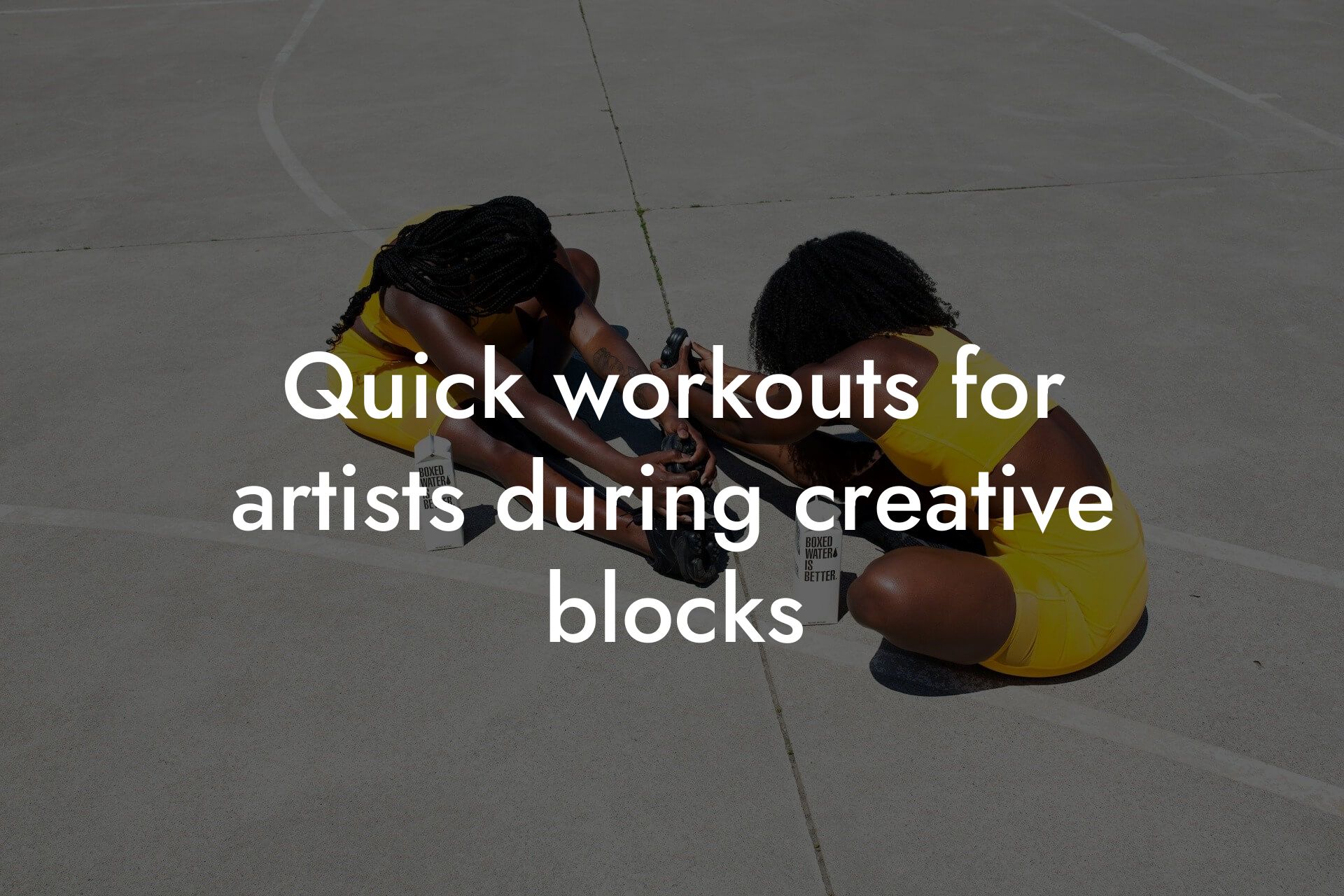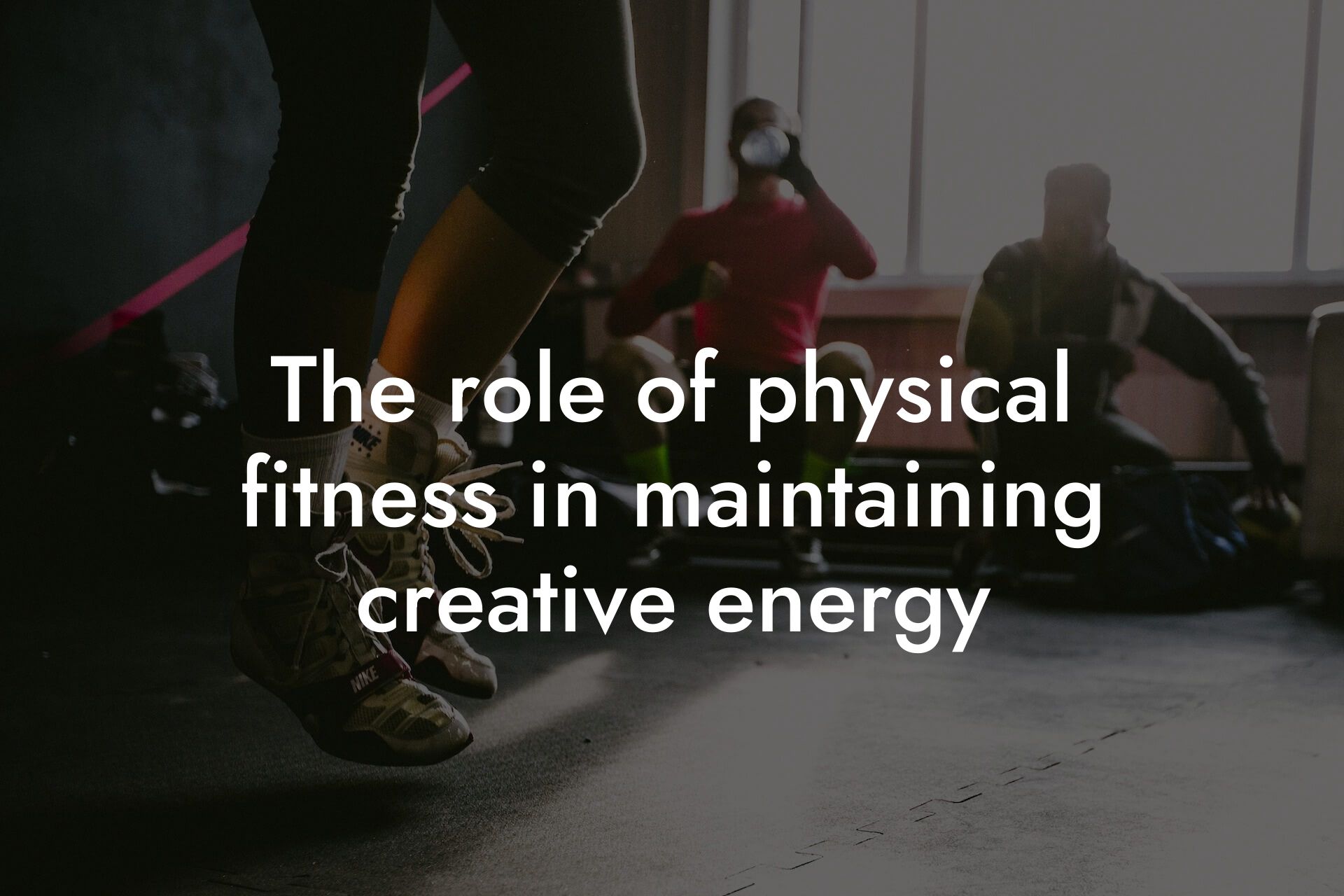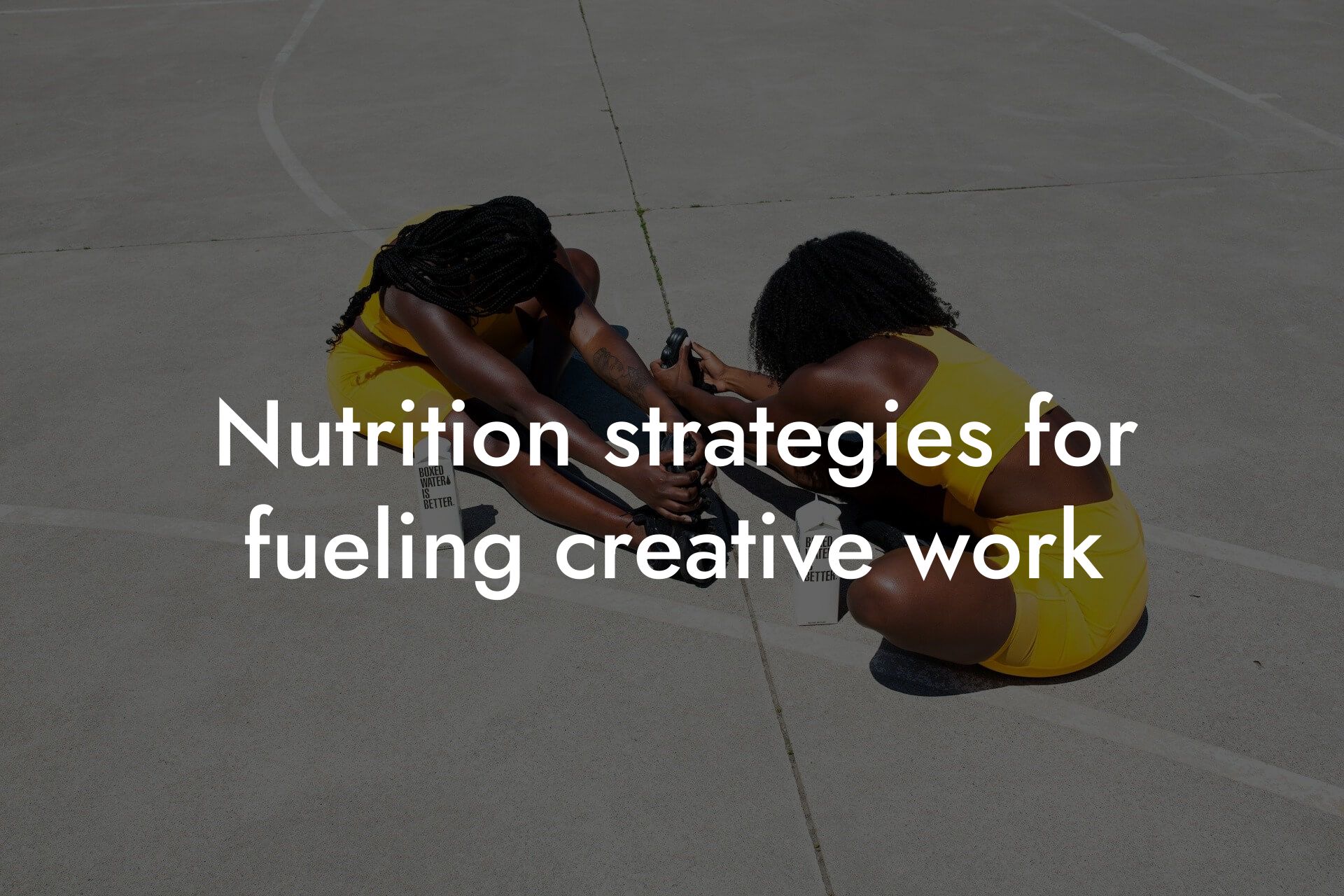As a high-earning professional in a creative field, you're no stranger to stress. Long hours, tight deadlines, and high expectations can take a toll on your mental and physical well-being. However, incorporating physical fitness into your lifestyle can be a game-changer in managing stress and unlocking your full potential.
Table of Contents
- The Impact of Stress on Creative Professionals
- The Benefits of Physical Fitness for Stress Relief
- Choosing the Right Exercise for Stress Relief
- Creating a Fitness Routine for Busy Creative Professionals
- The Importance of Body Composition for Creative Professionals
- Combining Physical Fitness with Mindfulness for Optimal Stress Relief
- Overcoming Barriers to Exercise for Creative Professionals
- Frequently Asked Questions
The Impact of Stress on Creative Professionals
Stress is a common affliction among creative professionals. The pressure to constantly produce innovative ideas, meet tight deadlines, and manage multiple projects can lead to feelings of anxiety, burnout, and exhaustion. Chronic stress can negatively impact your physical and mental health, leading to symptoms such as insomnia, digestive problems, and a weakened immune system. Moreover, stress can stifle creativity, making it challenging to come up with fresh ideas and solutions.
The Benefits of Physical Fitness for Stress Relief
Regular physical activity is a powerful tool for managing stress. Exercise releases endorphins, also known as "feel-good" hormones, which can help alleviate symptoms of anxiety and depression. Physical fitness can also improve sleep quality, boost energy levels, and enhance cognitive function, making it easier to tackle complex creative projects. Furthermore, exercise can provide a healthy distraction from work-related stress, giving you a much-needed break from the constant pressure to perform.
Choosing the Right Exercise for Stress Relief
When it comes to managing stress through physical fitness, not all exercises are created equal. Activities that promote relaxation and reduce muscle tension are ideal for stress relief. Some excellent options include:
Yoga: This low-impact exercise combines physical postures, breathing techniques, and meditation to reduce stress and anxiety. Yoga can help calm the mind, relax the body, and improve overall well-being.
Pilates: This form of exercise focuses on core strength, flexibility, and body control. Pilates can help reduce muscle tension, improve posture, and enhance overall physical fitness.
Swimming: This low-impact aerobic exercise is easy on the joints and can help reduce stress and anxiety. Swimming can also improve cardiovascular health and boost mood.
Cycling: This low-impact cardio exercise can help reduce stress and anxiety by releasing endorphins and improving cardiovascular health. Cycling can also be a great way to clear your mind and enjoy the outdoors.
Creating a Fitness Routine for Busy Creative Professionals
Finding time to exercise can be challenging for busy creative professionals. However, incorporating physical fitness into your daily routine can be easier than you think. Here are some tips to get you started:
Schedule it in: Treat exercise as a non-negotiable part of your daily routine, just like brushing your teeth or taking a shower.
Start small: Begin with short, manageable sessions (20-30 minutes) and gradually increase the duration and intensity as you become more comfortable.
Find activities you enjoy: Engage in physical activities that bring you joy and make you look forward to exercising.
Make it convenient: Find exercises that can be done at home, in your office, or during your lunch break to save time and increase convenience.
The Importance of Body Composition for Creative Professionals
As a creative professional, your body composition plays a critical role in your overall health and well-being. Excess body fat can lead to chronic diseases, such as diabetes and cardiovascular disease, which can negatively impact your creativity and productivity. Moreover, poor body composition can affect your self-confidence and overall quality of life.
At Tano Performance Group, we understand the importance of body composition for high-earning professionals. Our state-of-the-art DEXA machine provides a comprehensive body assessment, giving you valuable insights into your body fat percentage, bone density, and lean muscle mass. With this information, you can create a personalized fitness plan tailored to your specific needs and goals.
Combining Physical Fitness with Mindfulness for Optimal Stress Relief
While physical fitness is essential for managing stress, it's equally important to incorporate mindfulness practices into your daily routine. Mindfulness techniques, such as meditation and deep breathing, can help calm the mind, reduce anxiety, and improve overall well-being. By combining physical fitness with mindfulness, you can create a powerful stress-relief strategy that addresses both physical and mental health.
Overcoming Barriers to Exercise for Creative Professionals
Despite the numerous benefits of physical fitness, many creative professionals struggle to incorporate exercise into their daily routine. Common barriers to exercise include lack of time, energy, or motivation. Here are some tips to overcome these barriers:
Find an exercise buddy: Having a workout partner can provide accountability, motivation, and social support.
Track your progress: Use a fitness tracker or journal to monitor your progress, celebrate your successes, and stay motivated.
Reward yourself: Treat yourself to something you enjoy after reaching a fitness milestone, such as a massage or a new workout outfit.
Seek professional guidance: Consult with a fitness expert or a healthcare professional to create a personalized fitness plan that suits your needs and goals.
Managing stress through physical fitness is a powerful strategy for creative professionals. By incorporating regular exercise into your daily routine, you can reduce stress and anxiety, improve your overall health and well-being, and unlock your full creative potential. Remember to choose exercises that promote relaxation and reduce muscle tension, create a fitness routine that suits your lifestyle, and combine physical fitness with mindfulness practices for optimal stress relief. At Tano Performance Group, we're committed to helping high-earning professionals like you achieve their fitness goals and take their business to the next level.
Frequently Asked Questions
What is the connection between physical fitness and stress management in creative roles?
Physical fitness plays a crucial role in managing stress in creative roles. When you engage in regular physical activity, your body releases endorphins, which are natural mood-boosters that help reduce stress and anxiety. Additionally, physical fitness improves sleep quality, increases energy levels, and enhances cognitive function, all of which are essential for coping with the demands of creative work.
How does stress affect creative professionals?
Stress can significantly impact creative professionals, leading to decreased productivity, poor concentration, and reduced motivation. Chronic stress can also lead to burnout, causing creative blocks, and decreased overall well-being. Moreover, stress can affect the quality of work, leading to mistakes, and a decline in performance.
What are some common stressors faced by creative professionals?
Creative professionals often face unique stressors, including tight deadlines, high expectations, criticism, and rejection. They may also experience pressure to constantly produce innovative ideas, manage multiple projects simultaneously, and deal with conflicting feedback from clients or colleagues.
How can physical fitness help alleviate stress in creative roles?
Regular physical fitness activities can help reduce stress in creative roles by providing a healthy outlet for emotions, improving mood, and increasing energy levels. Exercise also enhances cognitive function, allowing creative professionals to approach problems with a clearer mind and increased focus.
What types of physical fitness activities are most beneficial for stress management?
Aerobic exercises, such as running, cycling, or swimming, are excellent for reducing stress and anxiety. Yoga, Pilates, and other low-impact exercises can also help improve flexibility, balance, and overall well-being. Additionally, high-intensity interval training (HIIT) and strength training can increase energy levels and boost mood.
How often should I engage in physical fitness activities to manage stress?
Aim to engage in physical fitness activities at least 3-4 times a week, with a minimum of 30 minutes per session. Consistency is key, so try to establish a regular routine that works for you. Even small amounts of physical activity, such as taking a short walk during lunch breaks, can be beneficial for stress management.
Can physical fitness activities be adapted to fit my busy schedule?
Absolutely! You can incorporate physical fitness into your daily routine, even with a busy schedule. Try breaking up your workout into shorter sessions, such as 10-15 minute increments, or schedule your workouts during your lunch break. You can also explore online workout platforms, mobile apps, or home-based exercises that can be done in a short amount of time.
How can I prioritize physical fitness when I have a tight deadline?
It's essential to prioritize physical fitness, even when faced with tight deadlines. Try to schedule your workouts during times when you're most productive, such as early morning or late evening. You can also break up your work into smaller tasks, taking short breaks to engage in physical activity. Remember, taking care of your physical health can actually improve your productivity and focus.
What are some tips for incorporating physical fitness into my daily routine?
Start by scheduling your workouts in your calendar, just as you would any other appointment. Find an exercise buddy or accountability partner to help motivate you. Begin with small, achievable goals, and gradually increase the intensity and duration of your workouts. Make sure to listen to your body and rest when needed, and celebrate your progress along the way.
How can physical fitness improve my overall well-being as a creative professional?
Regular physical fitness can improve your overall well-being by reducing stress and anxiety, enhancing mood, and increasing energy levels. It can also improve sleep quality, boost self-confidence, and increase creativity and productivity. Additionally, physical fitness can reduce the risk of chronic diseases, such as heart disease, diabetes, and certain types of cancer.
What are some common misconceptions about physical fitness and stress management?
One common misconception is that physical fitness requires a significant amount of time and dedication. However, even small amounts of physical activity can be beneficial for stress management. Another misconception is that physical fitness is only for athletes or fitness enthusiasts, when in fact, it's essential for overall health and well-being, regardless of profession or fitness level.
How can I track my progress and stay motivated?
Use a fitness tracker, mobile app, or journal to track your progress, set goals, and celebrate milestones. Share your goals with a friend or accountability partner to increase motivation. Reward yourself for reaching certain milestones, and don't be too hard on yourself if you miss a workout or two. Remember, consistency is key, and progress may not always be linear.
What are some resources available for creative professionals looking to prioritize physical fitness?
Tano Performance Group offers a range of resources, including workout plans, nutrition guides, and wellness tips, specifically designed for high-earning professionals. You can also explore online fitness platforms, mobile apps, and local fitness studios that cater to busy professionals.
How can I make physical fitness a habit?
Make physical fitness a habit by scheduling it in your calendar, finding an exercise buddy, and tracking your progress. Start with small, achievable goals, and gradually increase the intensity and duration of your workouts. Celebrate your progress, and don't be too hard on yourself if you miss a workout or two. Consistency is key, and it may take time to develop a habit.
What are some common barriers to physical fitness for creative professionals?
Common barriers to physical fitness for creative professionals include lack of time, energy, or motivation. They may also face physical limitations, such as injuries or chronic health conditions, that make it challenging to engage in physical activity. Additionally, creative professionals may struggle with perfectionism, leading to feelings of guilt or shame when they don't meet their fitness goals.
How can I overcome barriers to physical fitness?
Overcome barriers to physical fitness by starting small, setting realistic goals, and celebrating progress. Find exercises that you enjoy, and schedule them in your calendar. Don't be too hard on yourself if you miss a workout or two, and remember that consistency is key. Seek support from friends, family, or a fitness professional, and prioritize self-care and self-compassion.
What are some benefits of incorporating physical fitness into my creative workflow?
Incorporating physical fitness into your creative workflow can improve productivity, increase focus, and enhance creativity. It can also reduce stress and anxiety, improve mood, and increase energy levels. Additionally, physical fitness can improve sleep quality, leading to better rest and recovery.
How can I make physical fitness a part of my creative routine?
Make physical fitness a part of your creative routine by scheduling it into your daily or weekly schedule. Try to incorporate physical activity into your breaks, such as taking a short walk or doing a few jumping jacks. You can also explore exercises that can be done at your desk, such as chair squats or desk push-ups.
What are some tips for staying motivated and consistent with physical fitness?
Stay motivated and consistent with physical fitness by setting realistic goals, tracking progress, and celebrating milestones. Find an exercise buddy or accountability partner to increase motivation. Reward yourself for reaching certain milestones, and don't be too hard on yourself if you miss a workout or two. Remember, consistency is key, and progress may not always be linear.
How can physical fitness improve my relationships with clients and colleagues?
Physical fitness can improve your relationships with clients and colleagues by increasing energy levels, improving mood, and enhancing cognitive function. It can also increase confidence, leading to more effective communication and collaboration. Additionally, physical fitness can improve your overall well-being, leading to a more positive and productive work environment.
What are some common myths about physical fitness and creative professionals?
One common myth is that creative professionals are not athletic or interested in physical fitness. However, many creative professionals prioritize physical fitness as a way to improve their overall well-being and enhance their creative work. Another myth is that physical fitness requires a significant amount of time and dedication, when in fact, even small amounts of physical activity can be beneficial for stress management and overall health.
Here are some related articles you might love...
- Quick workouts for artists during creative blocks
- The role of physical fitness in maintaining creative energy
- Nutrition strategies for fueling creative work
- How artists can stay fit during long studio sessions
- Balancing artistic work with personal fitness goals
- How to maintain bone density in sedentary artistic jobs
- How DEXA scans can benefit creative professionals
- The impact of body composition on creative performance
- The connection between physical health and creative output
Zak Faulkner
Zak Faulkner is a leading authority in the realm of physical health and body composition analysis, with over 15 years of experience helping professionals optimise their fitness and well-being. As one the experts behind Tano Performance Group, Zak has dedicated his career to providing in-depth, science-backed insights that empower clients to elevate their physical performance and overall health.
With extensive knowledge of DEXA technology, Zak specializes in delivering comprehensive body assessments that offer precise data on body fat, muscle mass, bone density, and overall physique. His expertise enables individuals to make informed decisions and achieve their fitness goals with accuracy and confidence. Zak’s approach is rooted in a deep understanding of human physiology, combined with a passion for helping clients unlock their full potential through personalised strategies.
Over the years, Zak has earned a reputation for his commitment to excellence, precision, and client-focused service. His guidance is trusted by top professionals who demand the best when it comes to their health. Whether advising on fitness programs, nutritional strategies, or long-term wellness plans, Zak Faulkner’s insights are a valuable resource for anyone serious about taking their health and fitness to the next level.
At Tano Performance Group, Zak continues to lead our Content Team revolutionising how professionals approach their physical health, offering unparalleled expertise that drives real results.




